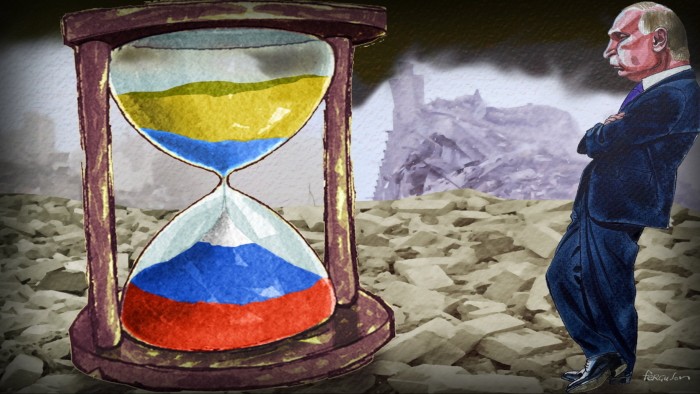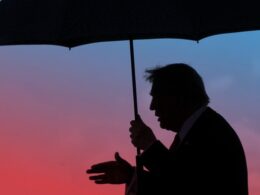Unlock the White House Watch newsletter for free
Your guide to what Trump’s second term means for Washington, business and the world
“Vladimir, STOP!” was Donald Trump’s plaintive message after a recent Russian bombing of Kyiv.
But Vladimir Putin is unlikely to stop. The Russian president thinks that time is on his side in his war on Ukraine — both on the battlefield and on the international stage. Trump is trying to press ahead with a peace plan — with calls to both Putin and Volodymyr Zelenskyy scheduled for Monday. The Ukrainian and Russian leaders are in oddly similar positions in the face of Trump’s diplomatic offensive.
Neither Putin nor Zelenskyy likes the look of Trump’s peace plan — despite the insistence of Marco Rubio, the US secretary of state, that it is the “best way forward”. But both Putin and Zelenskyy understand the dangers of antagonising Trump.
As a result, both Russia and Ukraine are adopting a similar strategy. They are playing along with Trump’s demands to talk about peace — while hoping that it is the other side that ultimately gets the blame, if and when peace efforts founder.
It is possible that, under American pressure, Ukraine and Russia will agree to a time-limited ceasefire. But the prospects of that hardening into a genuine peace settlement remain low — because the war aims of Russia and Ukraine remain profoundly incompatible.
The essential Russian goal still seems to be the termination of Ukraine’s existence as a sovereign and independent state. That would probably not mean the formal incorporation of Ukraine into Russia. But it would require treaty limits on the size and capabilities of the Ukrainian military — and on the country’s diplomatic and military ties to the west. Ukraine would emerge from such a settlement as a satellite state under the sway of Russia and at its mercy.
The current US plan was widely criticised in Europe for granting key Russian demands on the control of occupied territories and American recognition of Russian sovereignty over Crimea. But it still falls a long way short of what Russia wants — on the broader questions of Ukrainian sovereignty and neutrality.
Believing that Putin remains bent on the destruction of their country, the Ukrainians are also wary of America’s peace plan. Making territorial concessions over Crimea and eastern Ukraine is extremely difficult for Kyiv. But Zelenskyy is also reluctant to agree to anything that restricts Ukraine’s right to defend itself in future wars — or prevents it from building diplomatic, economic and security ties to the west.
Even if Nato membership is off the table, Ukraine still want bankable security guarantees from the west. Otherwise, the Ukrainians believe that Russia will simply use a ceasefire as an opportunity to get sanctions lifted — while preparing for the next round of fighting.
The question of who Trump blames — if and when peace talks fail — remains crucial. Putin’s best-case scenario is that Trump rounds on Zelenskyy — and then lifts sanctions on Russia and stops the supply of arms and battlefield intelligence to Ukraine. The Ukrainian government hopes that if Trump finally concludes that Putin is the real obstacle to peace, the US president will agree to intensify sanctions on Russia and send new supplies of weaponry to Ukraine.
Unfortunately, as things stand, it looks like the odds favour Russia. Trump’s long-standing admiration for Putin and his bubbling antagonism towards Zelenskyy make it likely that he will lose patience with the Ukrainian leader first. Trump is also attracted by the idea of a resumption of business ties with Russia. He would much prefer to sign lucrative new business deals in Moscow than agree to expensive new transfers of weaponry to Ukraine.
The Kremlin also has reason to hope that, if Trump loosens sanctions on Russia, there will be pressure inside the EU to weaken European sanctions. The failure of an ultranationalist pro-Russian candidate to win Romania’s presidential election over the weekend is a blow to Putin, but it does not guarantee the maintenance of EU sanctions, which have to be renewed unanimously — which means getting Hungary’s Viktor Orbán on board.
Even if Trump and the EU are persuaded to keep sanctions in place, after a failure of peace talks, a substantial reduction in US financial and military support for Ukraine is likely.
The position on the battlefield is finely balanced. Russia has been slowly gaining ground. But western military analysts believe that Putin’s army may soon not have enough tanks and armoured vehicles left to advance rapidly — if they were to break through Ukrainian lines.
Ukraine’s expertise in defensive and drone warfare is also inflicting staggering losses on Russia — estimated to be 1,500 troops killed or wounded a day. But some of the same sources who cite this figure think that Ukrainian casualties are running at roughly two-thirds the level of Russia’s. Given that Ukraine’s population is roughly a quarter that of Russia’s, Putin has reason to believe that he would ultimately prevail in a war of attrition.
Trump is right when he labels these grotesque levels of casualties a “bloodbath”. For all the criticism the US president receives, he is right to try to end the carnage.
The difficulty is that because Putin believes that time is on his side, Moscow has very little incentive to make the compromises necessary to achieve a lasting peace. If Trump truly wants “Vladimir” to stop, he is going to have to put some pressure on him.
Source link









